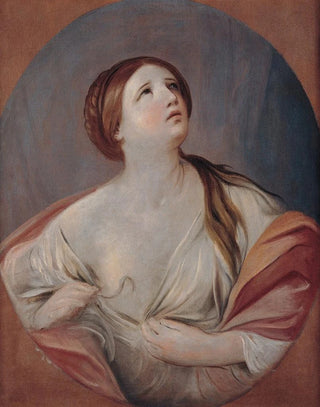Art print | Cleopatra - Guido Reni Source: Reproduction | Cléopâtre - Guido Reni


View from behind

Frame (optional)
In the fascinating universe of art history, certain works transcend time and continue to spark our curiosity. The art print Cléopâtre - Guido Reni is a shining example. This painting, created in the 17th century, not only demonstrates the technical mastery of its artist but also the richness of the themes explored. The depiction of Cléopâtre, an iconic figure of beauty and tragedy, invites an exploration of human emotions and mythological stories. By contemplating this piece, the viewer is transported to a world where art and storytelling intersect, offering a visual experience that is as captivating as it is intellectually stimulating.
Style and uniqueness of the work
Guido Reni's style is distinguished by his subtle use of light and color, creating an atmosphere that is both dramatic and gentle. In the representation of Cléopâtre, the chosen palette evokes rich nuances, ranging from dazzling golds to deep reds, emphasizing the royal and tragic character of the Egyptian queen. Reni, influenced by the Baroque movement, manages to capture an emotional intensity that emanates from the expression of his model. The carefully crafted details, from the drapery of the gown to the delicate features of the face, testify to a technical virtuosity that makes this work a masterpiece of classical painting. The posture of Cléopâtre, both majestic and melancholic, embodies the very essence of her character: a powerful woman, but also vulnerable in the face of her destiny.
The artist and his influence
Guido Reni, born in Bologna in 1575, is one of the masters of Italian Baroque painting. His career, marked by collaborations with renowned artists and prestigious commissions, helped establish his status in the pantheon of great painters. Reni stands out for his ability to combine classicism with Baroque sensibility, influencing many artists of his time and future generations. His approach to light and composition paved the way for a new way of perceiving painting, where emotion and storytelling take precedence over simple representation. Through works like Clé

Matte finish

View from behind

Frame (optional)
In the fascinating universe of art history, certain works transcend time and continue to spark our curiosity. The art print Cléopâtre - Guido Reni is a shining example. This painting, created in the 17th century, not only demonstrates the technical mastery of its artist but also the richness of the themes explored. The depiction of Cléopâtre, an iconic figure of beauty and tragedy, invites an exploration of human emotions and mythological stories. By contemplating this piece, the viewer is transported to a world where art and storytelling intersect, offering a visual experience that is as captivating as it is intellectually stimulating.
Style and uniqueness of the work
Guido Reni's style is distinguished by his subtle use of light and color, creating an atmosphere that is both dramatic and gentle. In the representation of Cléopâtre, the chosen palette evokes rich nuances, ranging from dazzling golds to deep reds, emphasizing the royal and tragic character of the Egyptian queen. Reni, influenced by the Baroque movement, manages to capture an emotional intensity that emanates from the expression of his model. The carefully crafted details, from the drapery of the gown to the delicate features of the face, testify to a technical virtuosity that makes this work a masterpiece of classical painting. The posture of Cléopâtre, both majestic and melancholic, embodies the very essence of her character: a powerful woman, but also vulnerable in the face of her destiny.
The artist and his influence
Guido Reni, born in Bologna in 1575, is one of the masters of Italian Baroque painting. His career, marked by collaborations with renowned artists and prestigious commissions, helped establish his status in the pantheon of great painters. Reni stands out for his ability to combine classicism with Baroque sensibility, influencing many artists of his time and future generations. His approach to light and composition paved the way for a new way of perceiving painting, where emotion and storytelling take precedence over simple representation. Through works like Clé






